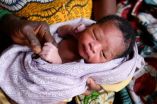(Press-News.org) CAMBRIDGE, Mass-- Materials that can be used for thermoelectric devices — those that turn a temperature difference into an electric voltage — have been known for decades. But until now there has been no good explanation for why just a few materials work well for these applications, while most others do not. Now researchers at MIT and elsewhere say they have finally found a theoretical explanation for the differences, which could lead to the discovery of new, improved thermoelectric materials.
The findings — by MIT graduate student Sangyeop Lee; Gang Chen, the Carl Richard Soderberg Professor of Power Engineering; and four others — are reported this week in the journal Nature Communications.
For thermoelectric applications, Chen explains, "It is important to find a material with low thermal conductivity" — since thermoelectrics work by maintaining a temperature difference from one side of a device to the other. If a material conducts heat well, then heat leaks quickly from the hot side to the cold side, reducing its efficiency in converting heat to electricity. But predicting which materials have low conductivity — which is to say, those that are good thermal insulators — has proved elusive.
For example, some compounds that are good insulators are made up of elements similar to those found in other compounds that are not good insulators at all. "Why," Chen wondered, "does one material have a low thermal conductivity, while another that is very similar does not?"
The solution to the puzzle turned out to come from work in other areas, including research to understand a different class called phase-change materials. These are being studied as a potential basis for computer memory devices that would retain information even when power is switched off. Phase-change materials change from an orderly, crystalline structure to a disordered structure in response to a change in temperature; they can then be switched back again with another temperature change.
Analysis of phase-change materials showed that they work because of a particular kind of chemical bonding, called resonant bonding — a type of bond in which electrons flip back and forth between several adjacent atoms. While resonant bonds' effects on electrical and optical properties have been studied, nobody had previously examined their effect on thermal properties, Lee says.
"There is little communication between people doing phase-change research and those doing thermoelectric research," Lee says. Interdisciplinary meetings at MIT helped lay the foundation for this research, he says: "This is an example where communication between people with different backgrounds can lead to new opportunities and boost understanding."
It turns out that electrons' "flipping" in resonant bonding leads to long-range interactions among their atoms, Chen says — producing the material's low thermal conductivity.
Using first-principles calculations to account for such behavior with resonant bonding, Lee was able to demonstrate that this effect could explain known discrepancies between similar materials that of low and high thermal conductivity.
"We found some general rules which can be used to explain other materials," Lee says.
This could lead to the discovery of new kinds of materials that also have very low thermal conductivity.
That, however, is just "one piece of the puzzle," Chen says: In order to be useful for thermoelectric devices, a material must combine low thermal conductivity with high electrical conductivity. Figuring out which materials possess that combination of characteristics will require further research, he says.
INFORMATION:
The work, which also included researchers at Rutgers University and at the University of Notre Dame, was partly supported by the U.S. Department of Energy, through the Solid State Solar-Thermal Energy Conversion Center, and by the Department of Defense.
Written by David Chandler, MIT News Office
Solving a mystery of thermoelectrics
New analysis explains why some materials are good thermal insulators while similar ones are not
2014-04-29
ELSE PRESS RELEASES FROM THIS DATE:
UNC researchers discover 'master regulator' role for little-known protein in cancer cells
2014-04-29
CHAPEL HILL, N.C. – Researchers in the UNC School of Medicine found that the protein DAZAP1 plays a key role in the regulation of many genes through a process known as alternative splicing, and when highly expressed in cancer cell line experiments, DAZAP1 was shown to inhibit several types of cancer cells from dividing and moving.
The discovery, published in the journal Nature Communications, marks the first time this little-known protein has been characterized in relation to cancer development and tumor growth.
"If you knock down DAZAP1, then most of the genes involved ...
Study yields potential drug targets for preeclampsia patients
2014-04-29
Preeclampsia, the most common complication of pregnancy, is a major cause of premature delivery and both maternal and fetal death, yet what causes the syndrome remains unclear. A new study indicates that molecules that send detrimental signals are abundant in certain tissues in preeclampsia patients. The study also documented some of the complications experienced by babies born to mothers with preeclampsia.
"Preeclampsia is a multifaceted complication found uniquely in the pregnant patient and one that has puzzled scientists for years," says the leader of the study, ...
CNIO team presents a new strategy to personalise cancer therapies
2014-04-29
Tumour cells can accumulate hundreds or even thousands of DNA mutations which induce the growth and spread of cancer. The number and pattern of mutations differs according to the type of tumour, even among those that are classified as part of the same type of tumours. This complexity, which researchers were not aware of just a few years ago, calls for new tools to filter relevant genetic information for the implementation and development of personalised therapies targeted at specific characteristics within each individual tumour.
Researchers led by Manuel Hidalgo, Vice-Director ...
Mathematicians trace source of Rogers-Ramanujan identities, find algebraic gold
2014-04-29
Mathematicians have found a framework for the celebrated Rogers-Ramanujan identities and their arithmetic properties, solving another long-standing mystery stemming from the work of Indian math genius Srinivasa Ramanujan.
The findings, by mathematicians at Emory University and the University of Queensland, yield a treasure trove of algebraic numbers and formulas to access them.
"Algebraic numbers are among the first numbers you encounter in mathematics," says Ken Ono, a number theorist at Emory "And yet, it's surprisingly difficult to find functions that return them ...
Proving uncertainty: New insight into old problem
2014-04-29
WASHINGTON D.C., April 29, 2014 -- Nearly 90 years after Werner Heisenberg pioneered his uncertainty principle, a group of researchers from three countries has provided substantial new insight into this fundamental tenet of quantum physics with the first rigorous formulation supporting the uncertainty principle as Heisenberg envisioned it.
In the Journal of Mathematical Physics, the researchers reports a new way of defining measurement errors that is applicable in the quantum domain and enables a precise characterization of the fundamental limits of the information accessible ...
Poor QOL doesn't predict low survival in high-risk lung cancer patients undergoing surgery
2014-04-29
Toronto, ON, Canada, April 29, 2014 – Quality of life (QOL) is rarely reported in surgical publications, yet it can be an important metric that can be of use to physicians and patients when making treatment decisions. Prior studies of average-risk patients undergoing lobectomy suggested that low baseline QOL scores predict worse survival in patients undergoing non-small cell lung cancer surgery. The results of a multi-center, longitudinal study of high-risk lung cancer patients who underwent sublobar resection counters this idea, finding that poor baseline global QOL scores ...
Mother's diet affects the 'silencing' of her child's genes
2014-04-29
A mother's diet before conception can permanently affect how her child's genes function, according to a study published in Nature Communications.
The first such evidence of the effect in humans opens up the possibility that a mother's diet before pregnancy could permanently affect many aspects of her children's lifelong health.
Researchers from the MRC International Nutrition Group, based at the London School of Hygiene & Tropical Medicine and MRC Unit, The Gambia, utilised a unique 'experiment of nature' in rural Gambia, where the population's dependence on own grown ...
Genealogy and biogeography meet personalized medicine
2014-04-29
Biogeographical data is useful in screening for disease risk and drug sensitivity associated with certain ethnic groups. A team of researchers, including an investigator from Children's Hospital Los Angeles, has developed a tool to accurately identify the biogeography of worldwide individuals. Previous tools were accurate in identifying place of origin within homogeneous European populations but highly inaccurate for places with significant immigration, such as the U.S.
Tatiana Tatarinova, PhD, of The Saban Research Institute of Children's Hospital Los Angeles, Eran ...
Screening out: What are parents doing to limit screen time for young children?
2014-04-29
ANN ARBOR, Mich. – About 25 percent of parents who have children aged two to five say their children get three or more hours of entertainment screen time a day, well beyond recommended limits, according to a new poll from the University of Michigan.
In the latest University of Michigan Mott Children's Hospital National Poll on Children's Health, a little more than half of those parents do try to set some limits by location: banning media devices from places like the bedroom or at mealtime.
In 2013, the American Academy of Pediatrics issued updated guidelines to recommend ...
People rely on what they hear to know what they're saying
2014-04-29
You know what you're going to say before you say it, right? Not necessarily, research suggests. A study from researchers at Lund University in Sweden shows that auditory feedback plays an important role in helping us determine what we're saying as we speak. The study is published in Psychological Science, a journal of the Association for Psychological Science.
"Our results indicate that speakers listen to their own voices to help specify the meaning of what they are saying," says researcher Andreas Lind of Lund University, lead author of the study.
Theories about how ...
LAST 30 PRESS RELEASES:
Norbert Holtkamp appointed director of Fermi National Accelerator Laboratory
New agentic AI platform accelerates advanced optics design
Biologists discover neurons use physical signals — not electricity — to stabilize communication
Researchers discover that a hormone can access the brain by hitchhiking
University of Oklahoma researcher awarded funding to pursue AI-powered material design
Exploring how the visual system recovers following injury
Support for parents with infants at pediatric check-ups leads to better reading and math skills in elementary school
Kids’ behavioral health is a growing share of family health costs
Day & night: Cancer disrupts the brain’s natural rhythm
COVID-19 vaccination significantly reduces risk to pregnant women and baby
The role of vaccination in maternal and perinatal outcomes associated with COVID-19 in pregnancy
Mayo Clinic smartwatch system helps parents shorten and defuse children's severe tantrums early
Behavioral health spending spikes to 40% of all children’s health expenditures, nearly doubling in a decade
Digital cognitive behavioral treatment for generalized anxiety disorder
Expenditures for pediatric behavioral health care over time and estimated family financial burden
Air conditioning in nursing homes and mortality during extreme heat
The Alps to lose a record number of glaciers in the next decade
What makes a good proton conductor?
New science reporting guide published for journalists in Bulgaria
New international study reveals major survival gaps among children with cancer
New science reporting guide published for journalists in Turkey
Scientists develop a smarter mRNA therapy that knows which cells to target
Neuroanatomy-informed brain–machine hybrid intelligence for robust acoustic target detection
Eight SwRI hydrogen projects funded by ENERGYWERX
The Lundquist Institute and its start-up company Vitalex Biosciences Announces Strategic Advancement of Second-Generation fungal Vaccine VXV-01 through Phase 1 Trials under $40 Million Competitive Con
Fine particles in pollution are associated with early signs of autoimmune disease
Review article | Towards a Global Ground-Based Earth Observatory (GGBEO): Leveraging existing systems and networks
Penn and UMich create world’s smallest programmable, autonomous robots
Cleveland researchers launch first major study to address ‘hidden performance killer’ in athletes
To connect across politics, try saying what you oppose
[Press-News.org] Solving a mystery of thermoelectricsNew analysis explains why some materials are good thermal insulators while similar ones are not



